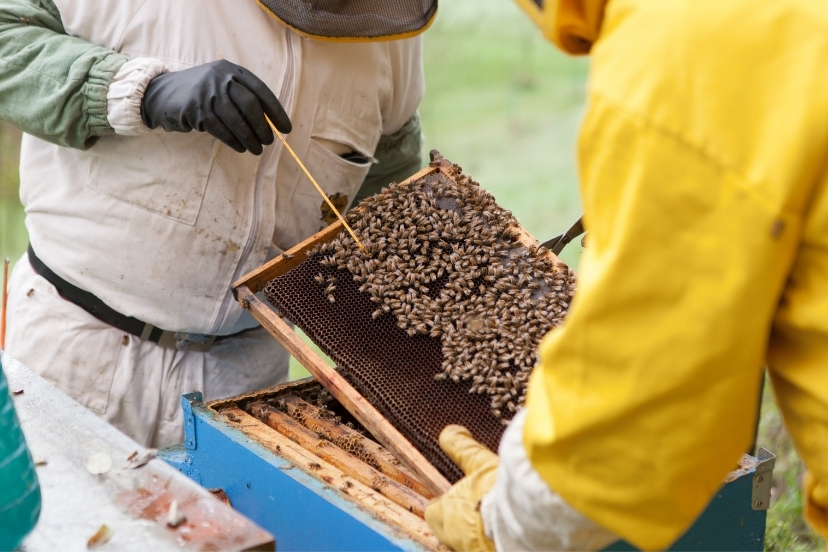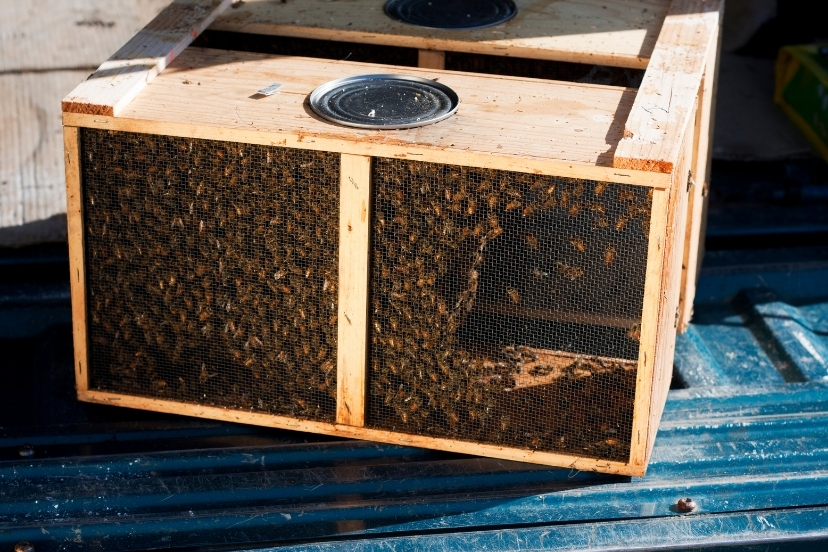I learned a lesson about the importance of using a bee smoker very early in my beekeeping career.
I was 15 or 16, and so I was not nearly as wise as I am now (OK, that sounds a little highfalutin’. How about: I’m not quite as ignorant now as I was then!).
I had only been keeping bees a short time, but figured that I really knew what I was doing.
One day I was out in the back yard doing something unrelated to the bees (probably trying to get out of mowing the yard.)
On a whim, I decided to take a quick peek into one of my hives. I wasn’t wearing any protective equipment, and I didn’t bother to get the bee smoker.
I only wanted to take a quick peek!
Let’s Get That Kid!
Well, it was as if those bees were laying in wait for me, with nothing better to do than teach an ignorant kid a lesson.
As soon as I pried the hive lid up just enough for bee bodies to squeeze through…
BAM!
BAM!
BAM!
Two stings on the arm and one on the leg. It was a very short peek indeed!
I Learned the Lesson Those Bees Taught Me…
Actually, several lessons could be derived from that episode of ignorance.
But since this is the smoker page, we’ll focus on that lesson: If I’d had a smoker going, it’s very unlikely that I would have been stung at all.
And I did heed the lesson the bees delivered that day: I’ve never since opened a hive without a bee smoker puffing away.
How Smokers Work…
In truth, we don’t fully understand just exactly all the ways in which smoke helps to modify bee behavior.
But we’re fairly certain of two effects of smoke in diminishing the defensive response of honey bees:
1) Creating Confusion
Each worker bee in a hive has a distinct job to perform. One of those jobs is guarding the hive.
Bees on guard duty spend their time at full alert, constantly vigilant for any threats to the hive’s security. At any indication of an intruder (that would be you, beekeeper!), they are the first to respond.
And if a guard bee decides that something is wrong, she releases a pheromone that alerts other bees to the situation.
The signal “intruder alert!” can spread very rapidly throughout the hive, making potentially thousands of bees ready to attack within just a few seconds.
But smoke wafting through the hive shuts that response down.
The smoke masks the alert pheromone, cutting the lines of communication. Because of the smoke, mass confusion reigns, where there otherwise might have been a mass retaliation against the intruder.
2) Setting Off Internal Alarms
The second way that smoke works is by setting off an internal fire alarm within each bee.
The bees seem to instinctively understand that smoke = fire = possible evacuation.
And just as you might grab your wallet or purse on the way out of your burning home, the bees prepare to evacuate by gorging themselves on honey. If they have to abandon their hive and start anew, they will need all of the honey they can carry for subsistence and for building new comb.
So between the crippled communications and the frantic engorgement upon honey, the bees are considerably less likely to respond defensively to your intrusion into their home.
Smoke Isn’t a Magic Shield…
If you’re a newbie beekeeper, don’t think of the smoke as an impermeable force field that will totally repel the bees.
The smoke is just a tool, which in combination with utilizing proper techniques and timing when working a hive, will keep the bees defensive response to a minimum.
Using Bee Smokers
The first step to using a bee smoker, obviously, is to get it lit with a nice, smoldering burn.
What should you use for fuel?
Well, if you ask 10 beekeepers that question, you might get 10 different answers. My favorite is “punky” wood: dry, partially rotted wood from a fallen tree or limb. (That’s what I used in the photo above.)
But you can use just about anything that’s convenient, and that will burn with a slow, smoky smolder. Just take care not to use anything that might have some undesirable chemicals in the smoke.
Sawdust or chips from treated wood, for example, would be a bad idea.
Also, if you happen to be a tobacco user, do NOT blow tobacco smoke on the bees; it’s poisonous to them.
Use tinder of some sort to start the fire.
In my area, dried pine needles are plentiful, and make excellent tinder. Once you have a good flame going with the tinder, start to feed in your smoker fuel, pumping the bellows until the bee smoker is producing a nice, thick smoke.
You don’t want to scorch the bees, so make sure that the smoke isn’t too hot.
One trick that will help to cool the smoke is to stuff a wad of green grass into the lid of the smoker before closing it.
Not Too Much Smoke, and Not Too Little…
Once your smoker is going good, step up to the side of the hive and direct a few puffs of smoke into the entrance. Wait a minute or two, and then crack open the lid and puff in some smoke.
Let the lid down, wait a little longer, and then remove the lid, puffing smoke over the top of the hive as you expose it.
As you work the hive, you’ll periodically add more smoke.
With experience, you’ll come to know when it’s time to give the bees more smoke by their behavior. When they start to act more agitated and animated, it’s time for more smoke.
Quite often you’ll see rows of bees ‘eyeballing’ you from in between the frames when their patience is running thin. You can almost hear them thinking: “OK, I’ve had just about enough of this guy!”
Prudence can be the Better Part of Valor
Some days just aren’t your day. That’s just as true in beekeeping as in any other aspect of life.
There will be times when the smoke just isn’t having the desired effect, and a retreat will be in order.
On such occasions, a professional beekeeper who needs to stay on schedule might just have to fight through it, but you don’t. Close the hive up, and come back on another day when it’ll be less traumatic for both the bees and their keeper.
And by the way, take care not to offend Smokey with your bee smoker; don’t start a forest fire! It’s not been unknown for one lone beekeeper to torch off a cataclysmic conflagration with a bee smoker!
A nice smoker for a newbie beekeeper
Shopping For Your First Smoker?
Are you a beginning beekeeper shopping for your first smoker?
You’ll find that there are lots of variations and refinements to the classic design.
But I would recommend that you be sure the smoker you select offers these two features:
A Large Fire Box: Nothing’s worse than running out of smoke right in the middle of a hive inspection – especially for a newbie beekeeper. And small smokers can flame out surprisingly quick.
A Safety Cage: Lots of smokers these days come with a wire cage surrounding the fire box. It’s a nice feature, because it reduces (but doesn’t eliminate) the chance of burning yourself by grabbing the smoker in the wrong place. (Been there, done that. Not fun!)
Here’s a bee smoker sold on Amazon that offers those features.
Just remember that the type of smoker you use isn’t nearly as important as the fact that you do use one.
Even just for quick peeks!


